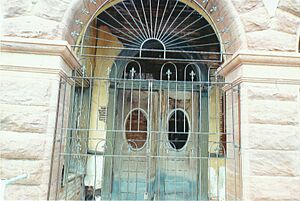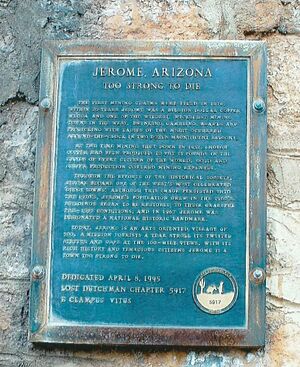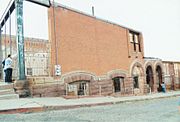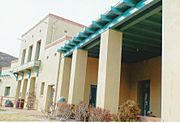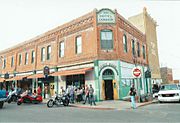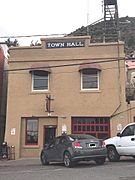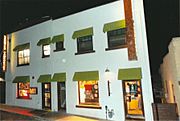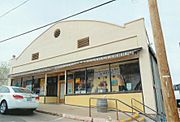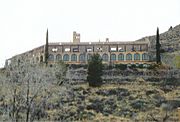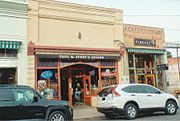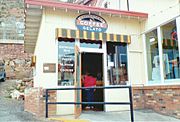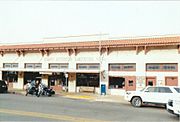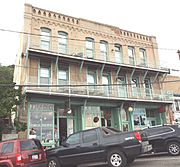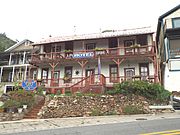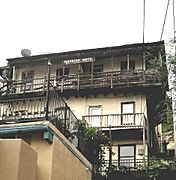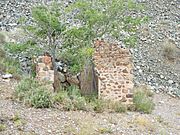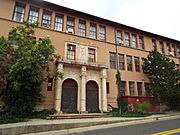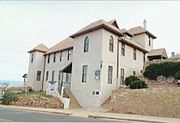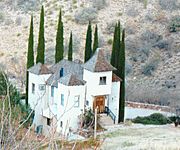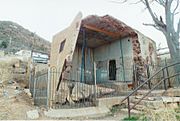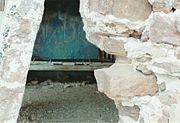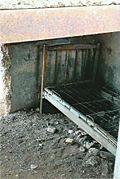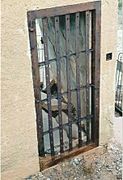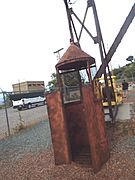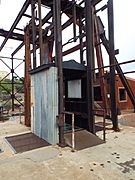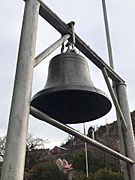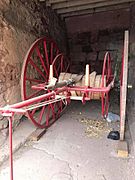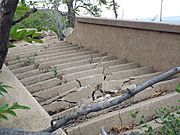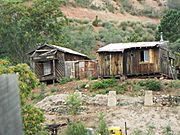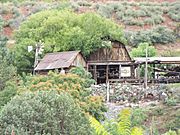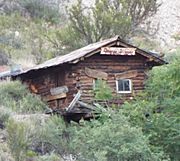List of historic properties in Jerome, Arizona facts for kids
Quick facts for kids
List of historic properties
in Jerome, Arizona |
|
|---|---|

Main Street and Jerome Avenue.
The Connor Hotel is on the left side corner and the Liberty Theater is next to it. |
Jerome, Arizona, is a cool town with a rich history, nestled in the Black Hills of Yavapai County, Arizona. It was founded in the late 1800s on Cleopatra Hill, looking over the beautiful Verde Valley. You can find Jerome between the cities of Phoenix and Sedona. This town is so special that it became a National Historic Landmark in 1967!
Many old buildings in Jerome are marked with special plaques by the Jerome Historical Society. These plaques help everyone know which buildings are important parts of the town's past. Even though Jerome is a historic place, not every building is officially "historic." This is because many are privately owned, and owners can choose to change or even tear down their buildings. But the Jerome Historical Society works hard to protect and share the town's unique story.
Contents
Jerome's Story: A Quick Look
First People and Explorers
Long, long ago, from about 700 to 1125 CE, the Hohokam people lived and farmed near Jerome. They were also the first miners here! They looked for colorful copper minerals like malachite and azurite, which they used to make pretty ornaments.
Later, Spanish explorers arrived in the area. They were looking for gold and silver, not copper, so they didn't mine much. This land eventually became part of Mexico. After the Mexican–American War and the 1848 Treaty of Guadalupe Hidalgo, the area became part of the United States.
Booming Copper Mines
In 1880, some people bought the mining claims in Jerome. Later, James A. MacDonald and Eugene Jerome joined them. They helped fund the mine, and the town was named after Eugene Jerome!
A very important person named William A. Clark bought the United Verde mines. He made big improvements, like building a larger smelter (a place to melt ore). He also built a special narrow gauge railway, the United Verde & Pacific Railway, to move the copper ore. Jerome officially became a town on March 8, 1898.
In 1914, another company, the United Verde Extension Mining Company (UVX), found a huge new copper deposit. This mine, also known as the Little Daisy Mine, became very successful and brought a lot of wealth to Jerome.
Jerome's Decline and Comeback
In the 1930s, during the Great Depression, the price of copper dropped a lot. This made it hard for the mines to stay open. In 1935, the Clark family sold their mine, and by 1938, the UVX mine closed. As the copper ran out, the mines shut down, and it looked like Jerome might become a ghost town.
Many buildings were lost during this time. Some sank into the ground, like the famous Jerome Jail, because the earth beneath them shifted. Others burned down or were torn down. For example, the Main Street Primary School was demolished in 1945. By the mid-1950s, Jerome, which used to be one of Arizona's biggest cities, was almost empty.
But a few people who still lived there didn't give up! They worked hard to save the town by focusing on tourism and shops. Their efforts paid off, and Jerome was saved! It became a National Historic Landmark in 1966, recognizing its important past.
Jerome Historical Society
The Jerome Historical Society was started in 1953. You can find their office at 407 Clark Street. In 1956, they made an agreement with the mining company, Phelps Dodge, to stop tearing down buildings in the main part of town.
The society's main goal is to "protect, preserve and present the unique physical and natural history of Jerome." This means they want to keep Jerome's history alive for everyone, now and in the future. Even if a building is historic, the society can't stop an owner from changing or tearing it down. But they do their best to encourage preservation.
Historic Buildings in Jerome
Not every building in the Jerome Historic District is officially historic. The ones that are, and have been recognized by the Jerome Historical Society, have a special plaque. Here are some of the historic buildings in Jerome:
- The abandoned Little Daisy Mine headquarters was built around the 1890s and is located at 50 Douglas Road.
- The Barlett Hotel was built in 1901 at the corner of Main and First Street.
- The Douglas Mansion was built in 1916 on Little Daisy Street.
- The Hotel Connor was built in 1898 at the corner of Main Street and Jerome Avenue.
- The Jerome City Hall was built around 1890 on Main Street.
- The Grand Hotel was built in 1926. It used to be the United Verde Hospital and is located at 200 Hill Street.
- The Jerome Palace was built in the 1900s at 410 Clark Street. It's now home to the "Haunted Hamburger" restaurant!
- The Lawrence Memorial Hall, also known as Spook Hall, was built in 1917 as a garage. It was a JCPenney store from 1937 to 1953. It's on Hull Avenue.
- The Liberty Theatre was a silent movie theater built in 1918 on Jerome Avenue. It stopped showing movies in 1929.
- The Little Daisy Hotel was built in 1917 at 100 Douglas Road.
- Paul & Jerry's Saloon was built in 1899. It had the Senate Saloon downstairs and a Chinese Restaurant upstairs. It's at 206 Main Street.
- The Reese and Amster Garage was built in 1920 at 111 Main Street.
- The Surgeon's Mansion was built in 1917. It was the home of the main surgeon for the United Verde Copper Company's hospital. It's at 100 Hill Street.
- The New State Motor Building was built in 1918. It was a car dealership and showroom upstairs, with a garage downstairs.
- The Mine Museum/Fashion Saloon and the Whitten Printers building were built in 1917 at the corner of Main Street and Jerome Avenue. The museum is in the front, and the printers were in the basement.
- The Sullivan Apartments were built in 1917 at 367 Main Street.
- The Boyd Hotel was built in 1890 at 331 Main Street.
- The Garcia House was built in 1885 at 541 Main Street. It was originally for mine managers and is now known as the Ghost City Inn Bed and Breakfast.
- The Haskins House/Haskins Apartments were built in 1888 on Main Street.
- The Grocery Store Ruins were built in 1900 at 220 1st Street. It's now called the "La Victoria Studio."
- The House of Joy was built in 1892.
- The ruins of the mine Guard House.
- The Old Jerome High School was built in 1923 at 885 Hampshire Ave.
Historic Buildings Pictured
Churches and Places of Worship
- The Haven Methodist Church was built in 1927 on Main Street.
- The Jerome Episcopal Christ Church was built in 1926 at 407 Clark Street. Today, it's used by the Jerome Historical Society for their archives and offices.
- The Powder Box Church was built in 1939 by Sabino Gonzales using stucco, wire mesh, and even old blasting powder boxes!
- Houses of Religious Worship
The Famous Sliding Jail
- The Sliding Jail was built in 1905. It was originally located between Main Street and Hull Avenue. In the mid-1930s, the ground beneath it started to move, and the jail slowly slid 225 feet down the hill to the middle of Hull Avenue! It's a great example of how Jerome's unstable ground affected its buildings.
Other Historic Items and Places
- The Audrey Shaft Headframe was built in 1918. It's the biggest wooden structure of its kind still standing in Arizona and is located on the State Park Road.
- The Audrey Shaft and UVX Operations cages were also built in 1918.
- The Mexican Pool is a swimming pool and community center built in 1927 for the UVX mine workers and their families. It was the first swimming pool in Arizona to have lights!
- The 1898 town Fire Alarm Bell on Main Street.
- Jerome Fire Fighting equipment from 1890.
- The Jerome Blast Furnace is one of two furnaces found in 1888. It's located at 303 Main Street.
- The ruins of the Main Street Primary School were built in 1914. It was located at the corner of Main Street (Arizona Route 89A) and Verde Avenue before it was torn down in 1945.
- The Laura Williams Memorial Park is on the land where Laura Williams used to have an antique museum filled with items from Jerome's past.
- The Irving Turbine and Generator and its shed are located on N. Jerome State Mine Museums Road. These were part of a power plant built in 1914 to help the mines.
- The Rocket Shovel and Dragline was introduced in 1938 and is located on Hampshire Avenue (Arizona Route A89). This machine was important because it was one of the first successful mining devices to replace human labor in clearing rock after blasting underground.
- Miscellaneous historical items
Gold King Mine Ghost Town
The Gold King Mine Ghost Town was started in 1890. This ghost town, located on Perkinsville Road, was once called “Haynes.” It has old mining equipment, a Stamp Mill (used to crush ore), and other historic buildings that you can see.
Other Historic Spots (Not Pictured)
Some other historic places in Jerome that aren't shown in pictures include:
- The Gibson Market building, built in 1917 at 681 Hampshire Avenue.
- The abandoned Jerome Cemetery, which is near Route 89A, past the Jerome Union High School.
See also



